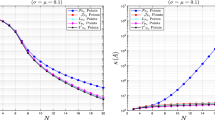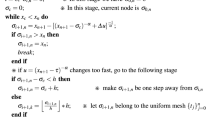Abstract
Tempered fractional derivatives and the corresponding tempered fractional differential equations have played a key role in physical science. In this paper, for solving the tempered fractional ordinary differential equation, the predictor–corrector (PC) methods with uniform and non-uniform meshes of Deng et al. (Numer Algorithms 74(3):717–754, 2017) are developed, by using the piecewise quadratic interpolation polynomial. The error bounds of proposed predictor–corrector schemes with uniform and equidistributing meshes are obtained. We proved that the presented numerical method has a higher-order convergence order \(O(h^3)\). Also, some numerical examples are constructed to demonstrate the efficacy and usefulness of the numerical methods. Finally, the results of PC schemes with uniform and non-uniform given in Deng et al. (2017) and presented schemes (improved PC with uniform and non-uniform meshes) are compared for different values of parameters.


Similar content being viewed by others
References
Butzer PL, Westphal U (2000) An introduction to fractional calculus. In: Hilfer R (ed) Applications of fractional calculus in physics. World Scientific, Singapore, pp 1–85
Heymans N, Podlubny I (2006) Physical interpretation of initial conditions for fractional differential equations with Riemann–Liouville fractional derivatives. Rheol Acta 45(5):765–771
Miller KS, Ross B (1993) An introduction to the fractional calculus and fractional differential equations. Wiley, London
Ali Z, Kumam P, Shah K, Zada A (2019) Investigation of Ulam stability results of a coupled system of nonlinear implicit fractional differential equations. Mathematics 7(4):341
Shah R, Khan H, Arif M, Kumam P (2019) Application of Laplace–Adomian decomposition method for the analytical solution of third-order dispersive fractional partial differential equations. Entropy 21(4):335
Saoudi K, Agarwal P, Kumam P, Ghanmi A, Thounthong P (2018) The Nehari manifold for a boundary value problem involving Riemann–Liouville fractional derivative. Adv Differ Equ 2018(1):263
Chaipunya P, Kumam P (2015) Fixed point theorems for cyclic operators with application in fractional integral inclusions with delays. Conference Publications
Podlubny I (1999) Fractional differential equations: an introduction to fractional derivatives, fractional differential equations, to methods of their solution and some of their applications. Mathematics in science and engineering, vol 198. Elsevier, Amsterdam
Kilbas AA, Marichev OI, Samko SG (1993) Fractional integral and derivatives (theory and applications), vol 1. Gordon and Breach, Basel
Debnath L (2003) Recent applications of fractional calculus to science and engineering. Int J Math Math Sci 54:3413–3442
Mainardi F (2010) Fractional calculus and waves in linear viscoelasticity: an introduction to mathematical models. World Scientific, Singapore
Zaslavsky GM (2002) Chaos, fractional kinetics, and anomalous transport. Phys Rep 371(6):461–580
Matignon D (1996) Stability results for fractional differential equations with applications to control processing. In: Computational Engineering in Systems Applications, IMACS. IEEE-SMC Lille, France, vol 2, pp 963–968
Matignon D, d’Andrea B (1997) Novel, observer-based controllers for fractional differential systems, In: Proceedings of the 36th IEEE Conference on Decision and Control, 1997, vol 5. IEEE, pp 4967–4972
Diethelm K, Ford NJ, Freed AD (2004) Detailed error analysis for a fractional adams method. Numer Algorithms 36(1):31–52
Meerschaert MM, Sabzikar F, Phanikumar MS, Zeleke A (2014) Tempered fractional time series model for turbulence in geophysical flows. J Stat Mech Theory Exp 2014(9):P09023
Sheng H, Chen Y, Qiu T (2011) Fractional processes and fractional-order signal processing: techniques and applications. Springer, Berlin
Reyes-Melo E, Martinez-Vega J, Guerrero-Salazar C, Ortiz-Mendez U (2005) Application of fractional calculus to the modeling of dielectric relaxation phenomena in polymeric materials. J Appl Polym Sci 98(2):923–935
Schumer R, Benson DA, Meerschaert MM, Wheatcraft SW (2001) Eulerian derivation of the fractional advection–dispersion equation. J Contam Hydrol 48(1–2):69–88
Heymans N, Bauwens JC (1994) Fractal rheological models and fractional differential equations for viscoelastic behavior. Rheologicaacta 33(3):210–219
Raberto M, Scalas E, Mainardi F (2002) Waiting-times and returns in high-frequency financial data: an empirical study. Phys A Stat Mech Appl 314(1–4):749–755
Magin RL (2010) Fractional calculus models of complex dynamics in biological tissues. Comput Math Appl 59(5):1586–1593
Meral F, Royston T, Magin R (2010) Fractional calculus in viscoelasticity: an experimental study. Commun Nonlinear Sci Numer Simul 15(4):939–945
El-Sayed A, Gaber M (2006) The adomian decomposition method for solving partial differential equations of fractal order in finite domains. Phys Lett A 359(3):175–182
Golbabai A, Sayevand K (2011) Analytical treatment of differential equations with fractional coordinate derivatives. Comput Math Appl 62(3):1003–1012
Heris MS, Javidi M (2017) On fractional backward differential formulas for fractional delay differential equations with periodic and anti-periodic conditions. Appl Numer Math 118:203–220
Heris MS, Javidi M (2017) On fbdf5 method for delay differential equations of fractional order with periodic and anti-periodic conditions. Mediterr J Math 14(3):134
Heris MS, Javidi M (2018) On fractional backward differential formulas methods for fractional differential equations with delay. Int J Appl Comput Math 4(2):72
Heris MS, Javidi M (2019) Fractional backward differential formulas for the distributed-order differential equation with time delay. Bull Iran Math Soc 45:1159
Buhmann MD (2003) Radial basis functions: theory and implementations, vol 12. Cambridge University Press, Cambridge
Javidi M, Heris MS (2019) Analysis and numerical methods for the Riesz space distributed-order advection–diffusion equation with time delay. SeMA J 1–19
Heris MS, Javidi M (2018) Second order difference approximation for a class of Riesz space fractional advection–dispersion equations with delay. ar**v preprint ar**v:1811.10513
Diethelm K, Ford NJ, Freed AD (2002) A predictor–corrector approach for the numerical solution of fractional differential equations. Nonlinear Dyn 29(1–4):3–22
Deng W (2007) Short memory principle and a predictor–corrector approach for fractional differential equations. J Comput Appl Math 206(1):174–188
Deng W (2007) Numerical algorithm for the time fractional Fokker–Planck equation. J Comput Phys 227(2):1510–1522
Li C, Chen A, Ye J (2011) Numerical approaches to fractional calculus and fractional ordinary differential equation. J Comput Phys 230(9):3352–3368
Daftardar-Gejji V, Sukale Y, Bhalekar C (2014) A new predictor–corrector method for fractional differential equations. Appl Math Comput 244:158–182
Yan Y, Pal K, Ford NJ (2014) Higher order numerical methods for solving fractional differential equations. BIT Numer Math 54(2):555–584
Asl MS, Javidi M (2017) An improved PC scheme for nonlinear fractional differential equations: error and stability analysis. J Comput Appl Math 324:101–117
Asl MS, Javidi M (2018) Novel algorithms to estimate nonlinear fdes: applied to fractional order nutrient-phytoplankton–zooplankton system. J Comput Appl Math 339:193–207
Liu Y, Roberts J, Yan Y (2018) A note on finite difference methods for nonlinear fractional differential equations with non-uniform meshes. Int J Comput Math 95(6–7):1151–1169
Liu Y, Roberts J, Yan Y (2018) Detailed error analysis for a fractional adams method with graded meshes. Numer Algorithms 78(4):1195–1216
Zhang YN, Sun ZZ, Liao HL (2014) Finite difference methods for the time fractional diffusion equation on non-uniform meshes. J Comput Phys 265:195–210
Metzler R, Klafter J (2000) The random walk’s guide to anomalous diffusion: a fractional dynamics approach. Phys Rep 339(1):1–77
Cartea A, del Castillo-Negrete D (2007) Fractional diffusion models of option prices in markets with jumps. Phys A Stat Mech Appl 374(2):749–763
Hanyga A (2001) Wave propagation in media with singular memory. Math Comput Model 34(12–13):1399–1421
Meerschaert MM, Zhang Y, Baeumer B (2008) Tempered anomalous diffusion in heterogeneous systems. Geophys Res Lett 35:L17403
Deng J, Zhao L, Wu Y (2017) Fast predictor–corrector approach for the tempered fractional differential equations. Numer Algorithms 74(3):717–754
Kilbas AAA, Srivastava HM, Trujillo JJ (2006) Theory and applications of fractional differential equations, vol 24. Elsevier Science Limited, Amsterdam
Hanyga A (2001) Wave propagation in media with singular memory. Math Comput Model 34:1399–1421
Metzler R, Joseph K (2000) The random walk’s guide to anomalous diffusion: a fractional dynamics approach. Phys Rep 339(1):1–77
Moghaddam BP, Machado JT, Babaei A (2018) A computationally efficient method for tempered fractional differential equations with application. Comput Appl Math 37(3):3657–3671
Meerschaert MM, Sabzikar F (2013) Tempered fractional Brownian motion. Stat Probab Lett 83(10):2269–2275
Li C, Deng W, Zhao L (2019) Well-posedness and numerical algorithm for the tempered fractional differential equations. Discrete Contin Dyn Syst B 24(4):1989–2015
Kelley CT (2003) Solving nonlinear equations with Newton’s method, vol 1. SIAM, Philadelphia
Acknowledgements
The authors would like to express special thanks to the referees for carefully reading, constructive comments and valuable remarks which significantly improved the quality of this paper. This project is supported by a research grant of the University of Tabriz.
Author information
Authors and Affiliations
Corresponding author
Additional information
Publisher's Note
Springer Nature remains neutral with regard to jurisdictional claims in published maps and institutional affiliations.
Appendix: Proofs of Theorems
Appendix: Proofs of Theorems
1.1 Proof of Theorem 1
Proof
By using Lemmas 1 and 2 and the Lipschitz property of f (2.6), let \(j=n+1\), for predictor formula (3.10), and we can write
then for corrector formula (3.4), we can write
Finally, by using the mathematical induction, for all \(0 \le j \le n + 1\), we have
\(\square \)
1.2 Proof of Lemma 3
Proof
By using the piecewise quadratic interpolation for \({{\mathrm{e}}^{ - \lambda ({t_j} - \tau )}}f(\tau ,u(\tau ))\) at the nodes \({t_{j - 2}}\), \({t_{j-1}}\) and \({t_{j}}\), we can write
where
By using (6.4) and (6.5), the proof is complete. \(\square \)
1.3 Proof of Lemma 5
Proof
By using the piecewise quadratic interpolation for \({{\mathrm{e}}^{ - \lambda ({t_{n + 1}} - \tau )}}f(\tau ,u(\tau ))\) at the nodes \({t_{{n_{i - 2}}}}\), \({t_{{n_{i - 1}}}}\) and \({t_{{n_{i}}}}\) in the predictor formula, we have
where
by using (6.6) and (6.7), the proof is complete. \(\square \)
1.4 Proof of Lemma 7
Proof
Let \({{\tilde{f}}_1}\) and \({{\tilde{f}}_2}\) be the piecewise quadratic interpolation for \({{\mathrm{e}}^{\lambda t}}f(t)\) with nodes, \({t_{{n_i}}},{t_{{n_{i+1}}}},{n_{{n_{i+2}}}}\), and \({t_{j}},{t_{j+1}},{t_{j+2}}\), respectively. Since
if we take \(f(\tau ) \equiv 1\) and \(\lambda =0\), we can write
by using (6.8) and (6.9), we have
We let \(G(t) = {{\mathrm{e}}^{\lambda t}}f(t)\), by combining (3.21, 4.29, 4.32) and (6.10), and we can write
where \({\xi _S} \in [{t_{{n_i}}},{t_S}]\). For equal-area distribution method, by the use of (4.10), we have
therefore, we can write
and by using (6.11) and (6.12), finally we have
For the equal-height distribution method, we assume
therefore, we can write
by using (4.6), we have
and thus,
where \({H_{{n_{{i^*}}}}} = \frac{{({n_{{i^*} + 1}} - {n_{{i^*}}}){{\mathrm{e}}^{\lambda ({t_{n + 1}} - {t_{{n_{{i^*} + 1}}}})}}}}{{\lambda ({n_{{i^*} + 2}} - {n_{{i^*} + 1}})}}\). By using (6.11) and (4.6)
and finally, we have
\(\square \)
Rights and permissions
About this article
Cite this article
Saedshoar Heris, M., Javidi, M. A predictor–corrector scheme for the tempered fractional differential equations with uniform and non-uniform meshes. J Supercomput 75, 8168–8206 (2019). https://doi.org/10.1007/s11227-019-02979-3
Published:
Issue Date:
DOI: https://doi.org/10.1007/s11227-019-02979-3




